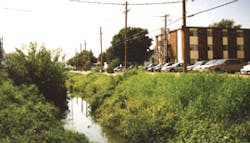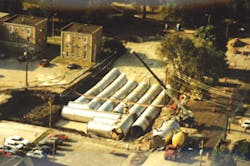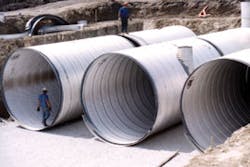City of Champaign Combines Public-Sector Input and Design-Build Concept to Solve Major Flooding Problem
Despite its ghoulish name, Boneyard Creek had a peaceful history for nearly two centuries until commercial and residential developments evolved nearby, turning it into a public nuisance. Named for the many skeletal bones discovered nearby, the creek’s natural function has been to collect runoff within the western sections of a watershed inside the boundaries of the city of Champaign, IL. The creek conveyed the collected runoff eastward through the University of Illinois campus and Urbana to the Saline Branch of the Salt Fork River.
Until the mid-1800s, stream flow to the grass-covered, 5,000-ac. basin was insignificant. Nearing the new century, increased agricultural land use and reduced vegetative cover changed the basin’s characteristics. Combined with a growing urban population and new commerce, runoff into Boneyard Creek steadily increased, and frequent flooding developed.
Meanwhile, the campus was growing to major proportions with areas regularly subjected to multimillion-dollar flood-damage events. The “Campustown” area, a popular gathering spot, was regularly inundated by Boneyard Creek overflow.
In 1986, the Illinois Department of Transportation (IDOT) Division of Water Resources, dealing with a state highway within the affected area, proposed constructing detention systems along with channel improvements. One year after the IDOT proposal, Dannel McCollum was elected mayor of Champaign with Boneyard Creek at the top of his agenda. “This had become much more than a public nuisance,” remarked McCollum when talking about the new in-line detention system in the summer of 1998. “Flooding from the creek seriously threatened the continuation of Campustown and neighboring buildings. On the downstream end of the creek, some buildings and equipment on campus property incur expensive damage all too frequently. The hazardous and unhealthy situation had been tolerated too long. My goals seemed simple enough–stop or greatly minimize the flooding, reduce the city’s maintenance expenses, improve the creek’s appearance, and allow more recreational opportunities for the entire area.”
McCollum built the governmental partnerships needed to develop a mutually agreeable solution. Simultaneously, since an inexpensive solution was unlikely, he successfully urged the city council to set aside a quarter portion of a 1% sales-tax increase to begin property acquisitions and hire an engineering firm. The fund allowed the city to begin buying property and engage an engineering firm to develop a stormwater master plan.
Soon the task force got its first look at the consulting engineer’s various proposals. They found that a 200-ac.-ft. detention basin would have to be constructed in a heavily developed area. According to McCollum, “The proposal met the flood protection goal but not all of the other task force guidelines. There was also concern that the projected cost was very high, and there would be ongoing maintenance and operating expenses that we wanted to avoid.”
The task force developed a request for proposals (RFP) stating objectives and advertised their availability to the general public. According to Champaign City Engineer Jeffrey Smith, P.E., “The RFP, for which cost estimates were required, resulted in several interesting proposals. We narrowed the field to five that would receive close review. Discussions with potential builders resulted in new and diverse ideas.”
The city accepted two proposals. One was from Healy Street Associates for a 114-ac.-ft. detention basin. The other was submitted by newly formed Lamar LLC, whose principals are Joe Lamb, president of Champaign Asphalt Company, and Mike Martin, a private developer. This proposal, with its design-build basis, combined a large underground corrugated steel pipe (CSP) detention system with landscaping and a bike path.
“When developing our proposal, we studied concrete boxes and pipes, corrugated steel pipe and arch combinations, and various underdrain systems,” explains Lamb. “The most cost-effective and adaptable system used large-diameter CSP. Essentially, we modified an earlier idea and substituted large pipe, which has much more storage capacity per unit area than the stone-filled trench concept.”
Lamb consulted Contech Construction Products Inc., a major producer of CSP and other products, because of its experience in applying large-diameter CSP for below-grade stormwater management systems. Lamb was able to draw on Contech’s experience and engineering services for assurance that a CSP underground detention system would fit the confines of the existing right of way, meet the storage requirements, and permit full implementation of the much-desired complete stream enclosure.
Upon the adoption of Lamar’s plan, Daily & Associates Consulting Engineers Inc. began work on final layout and design. The new Healy Street detention basin would provide 114 ac.-ft. (about 37 million gal.) of temporary storage and reduce flow from the southwest branch by 96%. The below-grade detention system would provide an additional 20 ac.-ft. (6.5 million gal.) of storage capacity and is designed to regulate discharges at the downstream end. This attenuation of flow can prevent campus flooding up to the 25-year storm event. The CSP detention system, when discharging at the downstream edge of this project, will be reduced to two runs of pipe entering a concrete junction box situated beneath a municipal parking lot adjacent to Wright Street.
Most inflow to the CSP detention system will occur from the northern sector of the watershed via an inlet near Scott Park. These projects will be supplemented later by upgrading the open channel on the university property. Future work identified in the master plan includes new detention basins and channelization in the northwest portion of the watershed.
According to Tom Jordan of Daily & Associates, “The major inlet for the underground system is a large drop inlet structure situated in the south end of Scott Park. This structure connects to two 10-foot-diameter CSP pipes. Most of the subsurface drainage system is composed of nearly 8,600 lineal feet of 11-foot-diameter Aluminized Steel Type 2 CSP. In all, we will use nearly 9,300 lineal feet of Aluminized Steel Type 2 CSP with sizes ranging from 12 inches to 132 inches in diameter.”
Commenting on the selection of Contech CSP, Lamb points out, “Although these are large pipe sections, they are relatively lightweight and easier to handle than other materials. Also, the availability of factory-fabricated bends and tee fittings greatly reduced our onsite work.” A coating of Aluminized Steel Type 2, a product of AK Steel Corporation, resulted in durable, aluminum-alloy coated pipe with a service life approaching 100 years.
Completed in mid-1999, Phase I of the project is a study in how to manage a seemingly impossible situation by combining perseverance, teamwork, an open forum, and innovative design-build concepts. All flooding possibilities (based on 25-year storm data) have been eliminated, and some of the acreage has been removed from the 100-year floodplain. The new landscaped multiuse corridor, made possible by the totally underground water storage system, is a safe environment for pedestrians, and cyclists and hosts opportunities for a refocus of some businesses from Green Street to the Boneyard corridor.
In addition to containing the water in a major flood within the banks of the Boneyard and halting the almost yearly cycle of flooding, the goal of this 30-year project is to maintain or reduce the current flow of water into Urbana. An additional 62 ac.-ft. of detention is necessary in future phases to protect the area up to the 100-year storm event. In 2000, the Urbana City Council passed an ordinance to further improve the Boneyard Creek area, an agreement that took two and a half years to negotiate between Urbana, Champaign, and the University of Illinois. The agreement transferred responsibility for the creek area from Wright Street to Gregory Street to the university. Previously Urbana took responsibility for that area.
Nearly $17 million more in Boneyard work is included in the capital improvement plans for the City of Champaign for the next 10 years. The work includes modifying the creek through Scott Park and building two more dry-bottom detention basins along Second Street between Springfield and University Avenues in a four-block area.




